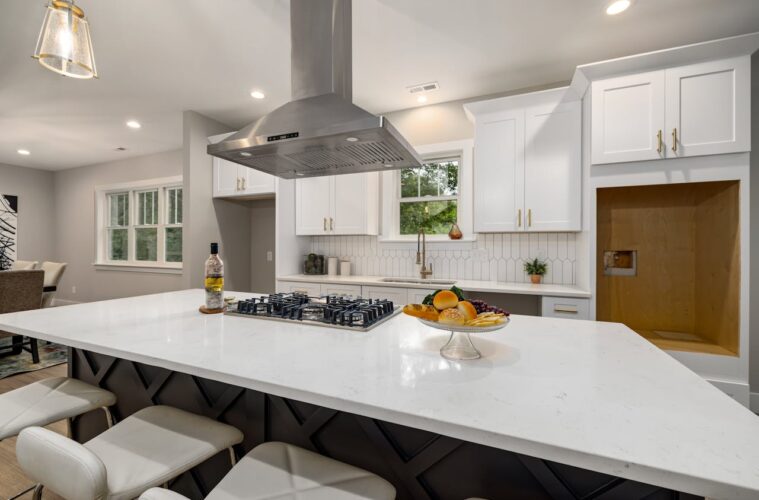The culinary aromas of a home-cooked meal might be enticing, but they often come with less welcome companions like smoke, grease, and persistent odours. Proper kitchen ventilation isn’t just about comfort; it’s about air quality and health.
Amidst the sleek countertops and the state-of-the-art appliances, the choice of how you ventilate your cooking space can have a lasting impact on the enjoyment and function of the heart of your home.
Whether you’ve just completed a renovation or are considering an update to your culinary fortress, the decision between installing a range hood and relying on window ventilation is not only one of preference but of practicality.
In this comprehensive guide, we’ll explore the advantages and drawbacks of both range hoods and windows, giving homeowners the information they need to make an informed decision that marries form with function.
Range Hood Ventilation
While cooking delights the taste buds, it also generates steam, smoke, and particulates that can linger in your kitchen and beyond. In both commercial settings and the modern home, the range hood has gained an essential status not just because of its functionality but also because of its role in contemporary kitchen design. From conventional to custom made hoods, there’s a range hood suited for every culinary space.
Pros:
- Effective Air Filtration: A range hood excels at vacuuming up the odours, smoke, and grease particles that are part and parcel of cooking, thereby improving the overall air quality within your home.
- Lighting: Many range hood models come equipped with lighting to illuminate your stovetop, enhancing visibility and adding to the ambiance of your kitchen.
Cons:
- Installation Costs: The initial setup can be steep, especially if ductwork needs to be added or modified in your home.
- Energy Use: These units draw electricity not only to operate the fan but also the light, contributing to your energy bills.
- Maintenance Requirements: Filters require regular cleaning and occasional replacement to maintain peak performance.
Window Ventilation
On the flip side, a good old-fashioned open window can provide ventilation and much more. It’s the most natural way to introduce air circulation into any room, including the kitchen. Strategically placed windows can aid in ventilating areas where heavy cooking happens, helping to clear out the airborne aftermath.
Pros:
- Natural Elements: The influx of natural light and fresh air can boost mood and contribute to a more enjoyable cooking environment.
- Lower Cost: With no need for installation or energy usage, window ventilation can be kinder on the wallet.
Cons:
- Limited Effectiveness: Windows can only do so much in dispelling smoke and odours—often leaving lingering reminders of your culinary pursuits.
- Weather Dependent: Your ventilation is at the mercy of the elements; rain or cold weather can dampen the window’s effectiveness quite literally.
- Security Issues: An open window can pose a security risk, especially if it’s easily accessible.
Range Hood Vs Window Comparison
When you weigh these factors against each other, you get a clearer picture of what each option brings to the table:
- Performance: The range hood has a significant edge in terms of removing cooking vapours and odours, whereas the window’s performance can vary based on a number of uncontrollable external factors.
- Cost: Windows are the winner in terms of initial and ongoing expenses. On the other hand, range hoods are a longer-term investment with recurring costs.
- Convenience: While both have their trade-offs, the range hood demands more in terms of space and maintenance, whereas a window offers a more low-maintenance and space-conserving solution.
Frequently Asked Questions
Do I need a hood if I have a window?
While a window can help, it doesn’t quite have the suction or filtration power of a hood. For those who cook often, especially with oils or at high temperatures, a range hood provides necessary ventilation that a window cannot match.
Do I really need a range hood?
If you find your kitchen’s atmosphere heavy with odours or smoke after cooking, it’s a sign your space could benefit from a dedicated ventilation system. A range hood might be an investment, but for avid kitchen users, it’s worth considering for long-term comfort and cleanliness.
In the end…
Ventilation is a crucial, yet often overlooked aspect of kitchen design. A well-ventilated kitchen is not only more pleasant to cook in but also safer and healthier for all home dwellers.
In considering range hoods versus window options, homeowners must reflect on their specific needs. If you find yourself frequently searing, frying, or sautéing, a range hood might be your best bet to keep those strong aromas at bay. Conversely, if you’re a fan of sunlight, fresh air, and a more natural setting —and you don’t mind the occasional scent of last night’s fish making a cameo at breakfast—window ventilation could be a perfectly adequate solution.
In essence, neither option is universally better than the other; it boils down to your kitchen’s setup, your cooking habits, and your personal priorities. A well-chosen ventilation method will not only clear the air but will also clear the path to more joyful cooking and serenity in your domestic sanctuary.



